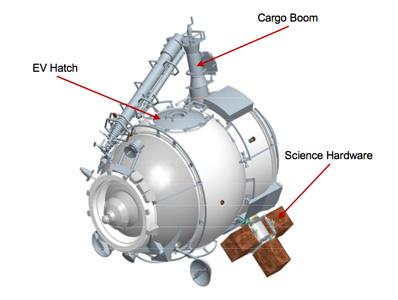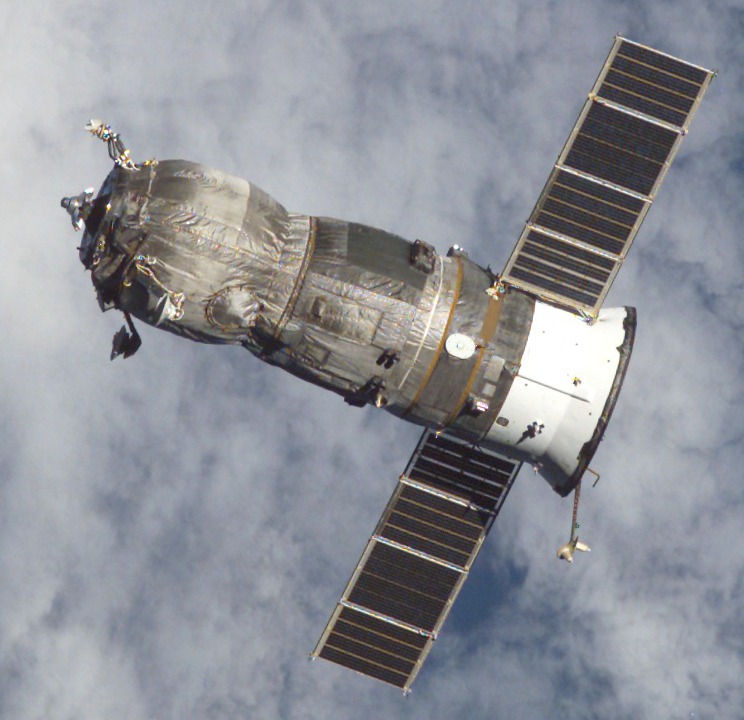|
List Of Progress Missions
This is a list of missions conducted by Progress automated spacecraft. Progress is an uncrewed Russian (previously Soviet) cargo spacecraft which has been used since 1978 to deliver supplies to Soviet space stations Salyut 6, Salyut 7, Mir, and later to the International Space Station. All launches have occurred from the Baikonur Cosmodrome. More than 150 flights have been launched, all except Progress M-12M, Progress M-27M and Progress MS-04/65P have reached their destinations, with no injuries or loss of life after launch; Progress M-12M and MS-04 failed during launch, whereas Progress M-27M experienced a spacecraft loss of attitude control while in orbit. The Progress M-24 spacecraft collided with Mir during a failed docking attempt in 1994, and Progress M-34 caused serious damage to the Spektr module when it drifted off course during a docking test in 1997. The spacecraft uses the automatic Kurs docking system for rendezvous with its destination space station, where crew a ... [...More Info...] [...Related Items...] OR: [Wikipedia] [Google] [Baidu] |
Progress 7K-TG
Progress 7K-TG (russian: Прогресс 7К-ТГ, italic=yes, GRAU index 11F615A15), was a Soviet uncrewed spacecraft used to resupply space stations in low Earth orbit. Forty three flew, delivering cargo to Salyut 6, Salyut 7, and Mir. It was the first version of the Progress spacecraft to fly, and spawned later derivatives including the Progress-M which replaced it, and the later Progress-M1. The Progress 7K-TG spacecraft was derived from the crewed Soyuz 7K-T ferry spacecraft, which had been designed for the Salyut programme. The descent module of the Soyuz spacecraft was replaced with a new section designated ''Otsek Komponentov Dozapravki'', or OKD. This contained fuel tanks and pumps used for refuelling the space station that it docked with. Like the Soyuz 7K-T, the Progress was not equipped with solar panels, and instead relied on batteries for power. Early spacecraft had a design life of 33 days, including three in free flight, and the rest docked with a space station ... [...More Info...] [...Related Items...] OR: [Wikipedia] [Google] [Baidu] |
TKS (spacecraft)
The TKS spacecraft (russian: Транспортный корабль снабжения, , ''Transport Supply Spacecraft'', GRAU index 11F72) was a Soviet spacecraft conceived in the late 1960s for resupply flights to the military Almaz space station. The spacecraft was designed for both crewed and autonomous uncrewed cargo resupply flights, but was never used operationally in its intended role – only four test missions were flown (including three that docked to Salyut space stations) during the program. The Functional Cargo Block (FGB) of the TKS spacecraft later formed the basis of several space station modules, including the Zarya FGB module on the International Space Station. The TKS spacecraft consisted of two spacecraft mated together, both of which could operate independently: * The VA spacecraft (known mistakenly in the West as the ''Merkur spacecraft''), which would have housed the cosmonauts during launch and reentry of a TKS spacecraft, while traveling to and fro ... [...More Info...] [...Related Items...] OR: [Wikipedia] [Google] [Baidu] |
Kosmos (satellite)
Kosmos (russian: Ко́смос, , meaning " (outer) space" or " Kosmos") is a designation given to many satellites operated by the Soviet Union and subsequently Russia. Kosmos 1, the first spacecraft to be given a Kosmos designation, was launched on 16 March 1962. History The first Soviet satellites orbiting Earth were named Sputnik, Polyot (starting in 1963), Elektron (in 1964), Proton (in 1965), and Molniya (in 1965), but most have been called Kosmos since Kosmos 1 on 16 March 1962. The program has included uncrewed tests of crewed spacecraft and satellites for scientific research and military purposes. , 2548 Kosmos satellites have been launched. The spacecraft do not form a single programme, but instead consist of almost all Soviet and Russian military satellites, as well as a number of scientific satellites, and spacecraft which failed during or immediately after launch, but still reached orbit. Most Soviet and subsequently Russian military satellites were given Kosm ... [...More Info...] [...Related Items...] OR: [Wikipedia] [Google] [Baidu] |
Kosmos 1669
Kosmos-1669 (russian: Космос-1669, italic=yes) was a Progress spacecraft used to resupply the Salyut 7 space station. It was a Progress 7K-TG spacecraft with the serial number 126. Mission Kosmos-1669 was launched by a Soyuz-U carrier rocket from Site 1/5 at the Baikonur Cosmodrome, at 13:05 UTC on 19 July 1985. The spacecraft docked with the aft port of Salyut 7 at 15:05 UTC on 21 July 1985. Following undocking on 28 August 1985, it moved away from the station, before returning and redocking to test the reliability of the docking system. It undocked for a second time at 21:50 UTC, and was deorbited on 30 August 1985, with the spacecraft burning up over the Pacific Ocean at 01:20 UTC. Salyut-7 Kosmos-1669 was the second cargo spacecraft (after Progress 24) to visit Salyut 7 after its reactivation, and also the last Progress flight as part of the Salyut programme. It delivered new spacesuit, to replace ones damaged by cold temperatures whilst Salyut 7 was deactivated, as ... [...More Info...] [...Related Items...] OR: [Wikipedia] [Google] [Baidu] |
Progress 7
Progress 7 () was a Soviet Union, Soviet unmanned Progress (spacecraft), Progress cargo spacecraft, which was launched in June 1979 to resupply the Salyut 6 space station. Spacecraft Progress 7 was a Progress 7K-TG spacecraft. The seventh of forty three to be launched, it had the serial number 107. The Progress 7K-TG spacecraft was the first generation Progress (spacecraft), Progress, derived from the Soyuz 7K-T and intended for uncrewed logistics missions to space stations in support of the Salyut programme. On some missions the spacecraft were also used to adjust the orbit of the space station. The Progress spacecraft had a dry mass of , which increased to around when fully fuelled. It measured in length, and in diameter. Each spacecraft could accommodate up to of payload, consisting of dry cargo and propellant. The spacecraft were powered by chemical batteries, and could operate in free flight for up to three days, remaining docked to the station for up to thirty. Launch ... [...More Info...] [...Related Items...] OR: [Wikipedia] [Google] [Baidu] |
Soyuz-U
The Soyuz-U launch vehicle was an improved version of the original Soyuz rocket. Soyuz-U was part of the R-7 family of rockets based on the R-7 Semyorka missile. Members of this rocket family were designed by the TsSKB design bureau and constructed at the Progress factory in Samara, Russia (now a united company, TsSKB-Progress). The first Soyuz-U flight took place on 18 May 1973, carrying as its payload Kosmos 559, a Zenit military surveillance satellite. The final flight of a Soyuz-U rocket took place on 22 February 2017, carrying Progress MS-05 to the International Space Station. Soyuz-U was in use continuously for almost 44 years. Production of R-7 derived launch vehicles peaked in the late 1970s-early 1980s at 55–60 a year. Soyuz-U held the world record of highest launch rate in a year in 1979 with 47 flights until this was beaten by SpaceX's Falcon 9 in 2022. Over its operational lifetime, the Soyuz-U variant flew a total of 786 missions, another world record. Soyuz ... [...More Info...] [...Related Items...] OR: [Wikipedia] [Google] [Baidu] |
Prichal (ISS Module)
''Prichal'' nodal module also known as Uzlovoy Module or UM (russian: Узловой Модуль "Причал", ''Nodal Module Berth'') is a Russian spacecraft which is part of the International Space Station (ISS). It was approved in 2011 and was launched on 24 November 2021, at 13:06:35 UTC, atop Progress M-UM, with operations beginning in 2022. Originally, the nodal module was intended to serve as the only permanent element of the future Orbital Piloted Assembly and Experiment Complex (OPSEK), but those plans were scrapped in 2017. Description ''Prichal'' is a nodal module that has a pressurized spherical ball-shaped design with six hybrid docking ports. It also has functional components located outside and inside it. The interior of the module is divided into two zones: habitable and instrument with on-board systems. The zenith port out of the six ports is active SSVP-M to allow docking with the space station, while the four ports are passive hybrids of SSVP-M call ... [...More Info...] [...Related Items...] OR: [Wikipedia] [Google] [Baidu] |
Poisk (ISS Module)
''Poisk'' (russian: Поиск, , Search), also known as the Mini-Research Module 2 (MRM 2), , or ''МИМ 2'', is a docking module of the International Space Station The International Space Station (ISS) is the largest modular space station currently in low Earth orbit. It is a multinational collaborative project involving five participating space agencies: NASA (United States), Roscosmos (Russia), JAXA .... Its original name was Docking Module 2 (, SO-2), as it is almost identical to the Pirs (ISS module), ''Pirs'' Docking Compartment. Added in 2009, ''Poisk'' was the first major Russian addition to the International Space Station since 2001. ''Poisk'' is overall the same design as the docking module ''Pirs''. Whereas ''Pirs'' had been attached to the nadir ("bottom") port of Zvezda (ISS module), ''Zvezda'', ''Poisk'' is attached to the zenith ("top"); ''Pirs'' was closer to the Earth with the ISS in its usual orientation, and ''Poisk'' is on the other side. ''Poisk' ... [...More Info...] [...Related Items...] OR: [Wikipedia] [Google] [Baidu] |
Pirs (ISS Module)
''Pirs'' ''(russian: Пирс'', meaning "pier") – also called Stykovochny Otsek 1 (SO-1; russian: Стыковочный отсек, "docking module") and DC-1 (Docking Compartment 1) – was a Russian module on the International Space Station (ISS). ''Pirs'' was launched on 14 September 2001, and was located on the '' Zvezda'' module of the station. It provided the ISS with one docking port for Soyuz and Progress spacecraft, and allowed egress and ingress for spacewalks by cosmonauts using Russian Orlan space suits. ''Pirs'' was docked to ''Zvezda'' for almost 20 years, until 26 July 2021, where it was decommissioned and undocked by Progress MS-16 to make way for the new '' Nauka'' module. Poisk module A second docking compartment, Stykovochniy Otsek 2 (SO-2), was planned with the same design. However, when the Russian segment of the ISS was redesigned in 2001, the new design no longer included the SO-2, and its construction was canceled. After another change of plans th ... [...More Info...] [...Related Items...] OR: [Wikipedia] [Google] [Baidu] |
Progress M
Progress-M (russian: Прогресс-М, GRAU indices 11F615A55 and 11F615A60), also known as Progress 7K-TGM, is a Russian, previously Soviet spacecraft which is used to resupply space stations. It is a variant of the Progress spacecraft, originally built in the late 1980s as a modernised version of the Progress 7K-TG spacecraft, using new systems developed for the Soyuz-T and Soyuz-TM spacecraft. The 11F61560 variant incorporated further modernisation, with digital flight control systems replacing the earlier analogue ones. The older 11F615A55 spacecraft outlived the newer 11F615A60. The final Progress-M, Progress-M-UM, was launched on 24 November 2021. The first forty three Progress-M spacecraft were used to resupply Mir, with subsequent spacecraft flying to the International Space Station. , eighty seven spacecraft have been launched, with sixty seven using the older model, and twenty using the newer version. Launches of the 11F615A60 are continuing. One 11F615A60, P ... [...More Info...] [...Related Items...] OR: [Wikipedia] [Google] [Baidu] |





